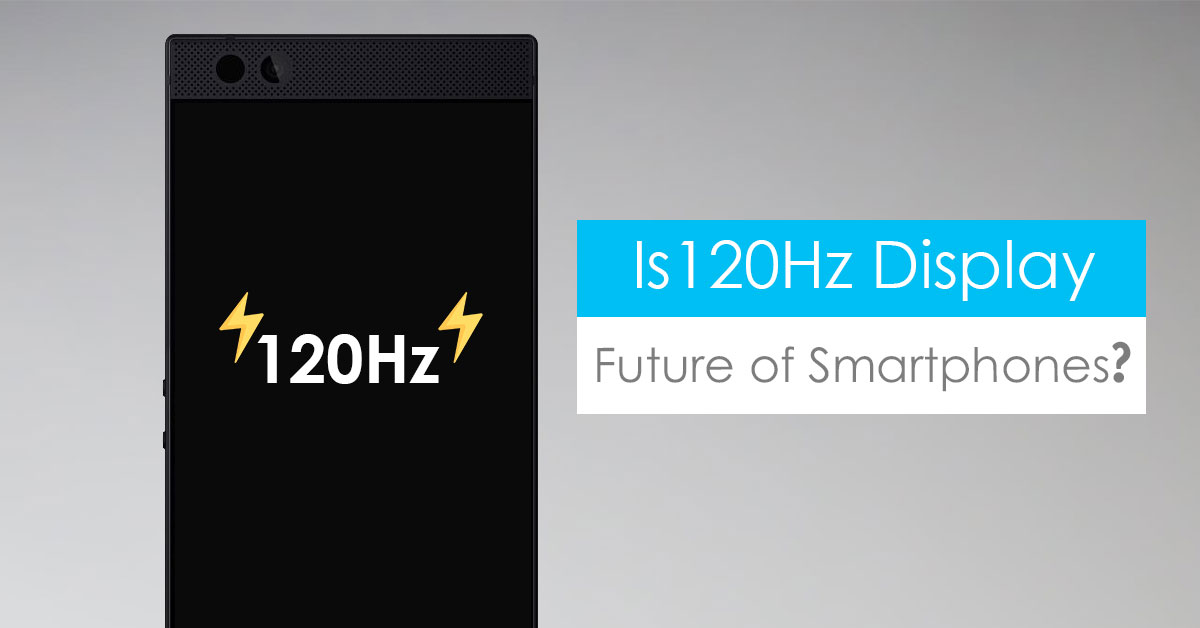
Previously when the smartphone space was starting to feel unimaginative, we began to see few new changes, especially in the display domain. First came the edge to edge panels, and recently when tall 18:9 aspect ratio were taking over there’s a new buzz of the 120Hz refresh rate displays. So whats up with this high refresh rate? Is it the next big thing on a smartphone?
So what is 120Hz refresh rate?
120Hz refers to the number of times a display panel can refresh itself. So with a 120Hz panel, it can refresh the display 120 times in one second. This can also be measured in terms of frames per second. In general, it’s a display that can render contents at 120fps. Higher the refresh rate, smoother the video appears, meaning it can capture fast movements by removing motion blurs. But there’s a limit to how much smoothness a human eye can perceive and how natural the content might look at higher frame rates. If you switch from 30fps to 60fps then the difference is immense but any further from 60fps just feels gimmicky for daily usage.
How does it affect viewing content?
Although the display might be refreshing on 120Hz, it’s likely useless if the content you’re viewing is running at the lower refresh rate. Basically, if we talk about smartphones, most of the apps run at 24 or 30fps and few games at 60fps. A 60fps video will be no different on either a 120Hz or a 60Hz display. Any content above 60fps is going to look unnatural and may seem extremely fast compared to what we are used to. Watching videos which involve people and them talking, then higher refresh rate will make it seem really unnatural but if it’s nature documentary, sports or gaming, then you’re in for a treat. It’s just the smoothness of the video and doesn’t have anything to do with the details.
On handheld devices, we have seen the 120Hz panel on Razer Blade Smartphone and the iPad Pro. Apart from videos, the high refresh rate will come in handy when you’re scrolling through contents, typing or switching apps.
Future of Smartphone Display
So in 2018, we might see few flagship phones with a 120Hz display as the craze for VR and AR contents are on the rise. The higher refresh rate will help to make the Augmented content appear more realistic with real-life motion. Obviously, it will need a faster processor to push the device which in turn will also be affecting the battery life. But these high refresh rate displays are usually adaptive as it will adapt refresh rate based on the content being displayed in turn saving the battery life. It’s almost certain that this feature won’t make it to most of the devices in 2018 and a better implementation may take some years. Instead, we will see bezel-less displays with fingerprint incorporated into the display, higher pixel density, new display panel maybe and even 3D displays which is in the making by the awesome camera manufacturer RED.




















![Best Mobile Phones Under Rs. 15,000 in Nepal [Updated] Best Phones Under 15000 in Nepal 2024 Budget Smartphones Cheap Affordable](https://cdn.gadgetbytenepal.com/wp-content/uploads/2024/03/Best-Phones-Under-15000-in-Nepal-2024.jpg)
![Best Mobile Phones Under Rs. 20,000 in Nepal [Updated] Best Mobile Phones Under NPR 20000 in Nepal 2023 Updated Samsung Xiaomi Redmi POCO Realme Narzo Benco](https://cdn.gadgetbytenepal.com/wp-content/uploads/2024/01/Best-Phones-Under-20000-in-Nepal-2024.jpg)
![Best Mobile Phones Under Rs. 30,000 in Nepal [Updated]](https://cdn.gadgetbytenepal.com/wp-content/uploads/2023/12/Best-Phones-Under-30000-in-Nepal-2024.jpg)
![Best Mobile Phones Under Rs. 40,000 in Nepal [Updated] Best Phones Under 40000 in Nepal 2024 Smartphones Mobile Midrange](https://cdn.gadgetbytenepal.com/wp-content/uploads/2024/02/Best-Phones-Under-40000-in-Nepal-2024.jpg)
![Best Mobile Phones Under Rs. 50,000 in Nepal [Updated] Best Phones Under 50000 in Nepal 2024 Smartphones Midrange](https://cdn.gadgetbytenepal.com/wp-content/uploads/2024/02/Best-Phones-Under-50000-in-Nepal-2024.jpg)
![Best Flagship Smartphones To Buy In Nepal [Updated] Best Smartphones in Nepal 2024 Flagship Premium Samsung Apple iPhone Xiaomi OnePlus Honor](https://cdn.gadgetbytenepal.com/wp-content/uploads/2023/09/Best-Smartphones-in-Nepal-2024.jpg)